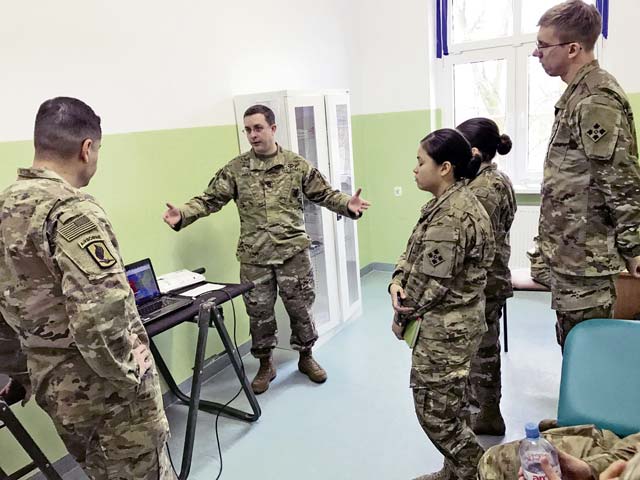
Sgt. 1st Class Todd Hall, Regional Health Command Europe Virtual Health noncommissioned officer in charge, explains the components of the Telehealth In a Bag kit to medics and providers during a recent training event. THIAB connects Soldiers in deployed environments with garrison health care providers and specialists at Landstuhl Regional Medical Center. — Photos by U.S. Army

“(TeleHealth In A Bag) is a telemedicine concept that enhances Soldier health care through an ability to rapidly extend the reach of the medical team,” according to Sgt. 1st Class Todd Hall, RHCE Virtual Health noncommissioned officer in charge. “The tool allows the health care team in the operational setting to seamlessly connect with specialists and other resources in garrison.”
In order to connect patients to specialists and providers from their home station, RAF providers are given a standardized telehealth equipment kit and issued a virtual exam conferencing space, which represents a secure, HIPAA-compliant private video chat room.
THAIB leverages a secure web-based platform, which enables deployed units to connect to providers anywhere and to share live diagnostic images with various peripheral device functions, including an otoscope, high definition examination camera, and heart and lung sounds using a stethoscope device.
“These peripheral devices can connect to any computer,” said Steven Cain, RHCE Virtual Health deputy and surgical physician assistant. “The best part is there is no extra software needed. The camera uses drivers already installed on the computer.”
There are different ways units can use the THIAB system. For example, health care providers, including medics, can connect to other medical units in their area or back to a fixed garrison medical element such as Vilseck Army Health Clinic in Vilseck, Germany. Second, they can connect with their unit’s organic provider or any one of 28 specialties at Landstuhl Regional Medical Center, Cain said.
One of the main uses of the THIAB to date is to connect Soldiers with their embedded behavioral health providers and unit behavioral health officers.
“Think about the Soldier who has been seeing the BH provider in garrison but is now going to this stressful deployment,” Cain said. “Who better to connect with the Soldier regularly than the person who has been seeing him for two years. We think that is a very powerful connection.”
This virtual health capability isn’t a new concept. Cain said that as early as 1992 providers at LRMC were trying to connect to Soldiers in remote locations with a satellite, computer and a printer for the photos. However, it took 23 minutes for the pictures to download and print.
“The need to reach back to organic unit medical resources in garrison or back to the medical center has not changed, just the technology” Cain said. “Provided an internet connection exists, we can leverage that connection to care for soldiers. It’s a readiness tool — to keep the group together, to keep them operational.”
Maj. Daniel Weinstein, regimental surgeon for the 2nd Cavalry Regiment in Vilseck, agrees that THIAB is a force multiplier.
“Integrating telehealth capabilities into our (aid stations), specifically for NATO’s enhanced forward presence mission, has allowed us to sustain the fighter far forward from the (military treatment facilities) and typical garrison-level care,” Weinstein said. “It also brings specialized care typically only seen at (hospitals) far forward, allowing 2CR to reduce the number of (medical evacuations). It has definitely expanded our ability to maintain readiness. It is the force multiplier that we need to revitalize our (aid stations and MTFs) moving forward.”
U.S. Army Europe and NATO aim to expand their capability with THIABs to reduce unnecessary evacuations and improve readiness.
“Operational telehealth is the right thing to do. We believe we are helping to fill an unmet need,” Cain said. “Bringing specialist care to the forward deployed or rotational Soldier can help keep them operational, keep the unit together to help complete the mission “
Currently, there are eight kits deployed to units across Eastern Europe, Turkey and Africa as well as a number of sites for just face to face communications.
“U.S. Army Europe bought eight THIAB kits,” according to Cain. “The RHCE virtual health team lends the units the virtual exam room space and provides the training, support and mentoring to help them use the equipment.”
Virtual health in Europe is growing rapidly. This growth is evident in the garrison environment and is being accelerated in the operational medicine setting to support requirements in theater, Hall said.
He went on to say that operational medical forces demanded a dynamic virtual health system that supports teams in austere locations.
“In late 2015, the USAREUR Surgeon’s Office requested assistance providing forward-deployed medics and providers with virtual health equipment to connect with other organic providers in support of Regionally Allocated Forces involved in Operation Atlantic Resolve,” Hall said.
Originally, the medical devices to support operational forces and telementorship were part of an AMEDD Advanced Medical Technology Initiative grant awarded by the Telemedicine and Advanced Technology Research Center.
“In the past, anyone on the medical team could only connect via data, voice and video and not through the advent of peripheral medical devices capable of transmitting biometric data that supports an enhanced picture of the patient,” Hall said.
At present, there are no other Army-wide enterprise solutions to provide this type of care to deployed forces in these locations outside of the THIAB.
“While we are trying to provide a capability to the Soldiers in the east, we are also trying to contribute to the body of knowledge in the Army and create an enterprise solution,” Cain said.
For more information on the RHCE Virtual Health program, visit https://rhce.amedd.army.mil/landstuhl/.


